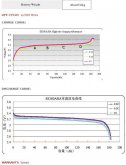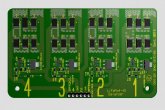My understanding of bottom balancing is based on the BMS's you buy from ali-express and the like which are usually fitted on DIY packs and inside dropins . They are possibly quite different to what you use if you are coming from a RC background . Some of
those balancers are different things altogether.
Balancing at a low value then allows the cells to fill up together to a point that at the most one cell goes over the top threshhold and everything turns off if a BMS is fitted. None of the other cells get there.
Now I believe the idea is to stay down round 90 % SOC max with your charger settings. If you don't have a BMS permanently connected on the negative line then how can you be sure one cell or more will not go over?
In fact when discharging, LFP cells spend the greater part of their capacity at around 3.2V. How will you tell if your cell is at A,B,Cor D in the below graph. (transpose those letters down to the lower discharge graph) See what I mean?
View attachment 828





